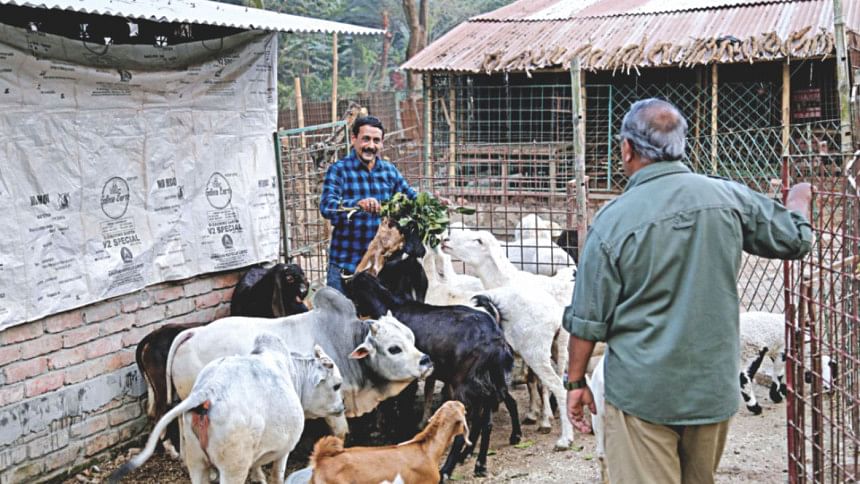Diverse foreign cattle species in Bangladeshi farm

My deepest reverence to the language martyrs. Without them Bangla would not be our state language and we wouldn't have achieved the global recognition of Ekushey February (February 21) as International Mother Language Day. In addition, I am proud to share with you all that on this glorious day, Hridoye Mati O Manush stepped into its 16th year of operation. Thank you all from across the world for your support!
Let's come into the article now. I don't have a farm of my own. But for the past 40 years, I have been with the farmers. I witnessed thousands of farms grow in the country; I telecast those on television. Many others followed. Some have succeeded, some failed. However, the news titled 'The country is self-sufficient in livestock' is quite comforting and amusing as well. Our progress in the farming sector is quite encouraging and inspiring. There is no doubt that a revolution in the livestock sector has taken place in the last few years. However, there is some difference between the official statistics and the real situation at the field level. During more than fourteen years of open discussion between policymakers and farmers at the field level, titled 'Kirshi Budget, Krishoker Budget' (budget on agriculture, budget for farmers), I have been hearing the stories of the farmers and different aspects regarding the policy on how necessary actions can be taken to resolve farmers' problems. I heard from Sirajganj, Manikganj and Sylhet that farmers are in crisis with managing their livestock. They don't have much information and illegal import of cows remains a prolonged problem.
In course of time, many unemployed young people have become self-reliant by establishing farms. Reports like women's success in bringing solvency to the family by raising goats are coming from districts and upazilas across the country, including areas in the remotest corners. Overall, except for a few odds, our development journey with livestock can now be termed as pretty much progressive.
Raising goats is very profitable in our country. Our 'Black Bengal' goats have great reputation worldwide. For its reproductive quality, skin and meat, it is adored by all. According to the United Nation's Food and Agriculture Organization (FAO) and the International Atomic Energy Agency (IAEA) 2015 data, Black Bengal goats are one of the best in the world.
Now the number of cattle farms is about 12 lakh (1.2 million), including small and large ones. In the last three years, the number of cows and goats in the country has increased by about two million. According to livestock department, in the fiscal year 2016-17, the number of cattle in the country was 5 crore 47 lakh 45 thousand (54.74 million). Among them, cow was 2 crore 39 lakh (23.9 million), bull 14 lakh 78 thousand (1.47 million), goats 2 crore 59 lakh (25.9 million) and sheep 34 lakh (3.4 million). This information proves that there is a lot of progress now both in terms of production and the variety of species of cattle.
For a long time working in the field, I have understood one thing very well. That is, people prefer variations. People always tend to go for something new. And if the new is an alternative to something necessary, then there is no doubt. In last January, I went to Jashore where I heard about Mahmudul Islam, a farmer who is different from others. When I reached Jashore's Chachara Pulerhat area, it was late afternoon.
Mahmudul's farm looks ordinary from outside. Inside the fences made of bamboo and wood, there is something different. Right after entering, I saw various species of animals. This is a farm of rare species of livestock collected from different countries of the world. In Bangladesh, such a farm is of great interest to us.
I talked to Mahmudul. In 2008, he started raising only two Hariyani goats just as a hobby. Later, he got interested in commercial cattle farming. The number of goats started growing day by day. On the other hand, he started collecting various species of cows, goats, bulls, garol, sheep and other animals. There are 100 species of animals in the farm. The animals are kept in different parts of the one-bigha farm. There are open spaces in front of tin-shed houses, with fences. He is raising these different animals in an open environment.
During the last few years, newspapers ran stories regarding Bhutti cow or Bhutani cows during the Eid-ul-Azha, a Muslim festival marked by sacrifice of animals. The cows are a little larger than big goats. Mahmudul's farm has three cows and a bull of such variety. He has collected them from Bhutan a couple of years ago. He also narrated the story. He went to Darjeeling in India. From there, he went to Bhutan for a day. There he got interested after seeing this cow. He imported the Bhutanese cow through a legal way. The price of the cow was Tk 30 thousand and another Tk 20 thousand spent to bring it to the country. Although small in size, due to special characteristics, now the price of this cow is very high in our country, said farmer Mahmudul Islam. Over two and a half years, the price of one cow has increased to Tk 1.5 lakh (approximately USD 1785). I wanted to know from Mahmudul Then why is the price of this small sized cow so much while people generally look for big cows that give more meat. Mahmudul's answer was that this cow has exceptionally more demand as its meat is delicious. Besides, there is a great demand for this cow for exhibitions in the zoo or urban areas.
There are also Chinese Barbara goats in this farm. It is also among the best goats in the world. Whose market value is quite good, says the farmer. He says he sells a pair of these goats for Tk 60,000 (approximately USD 714). And sells the calves pair for Tk 25,000 (approximately USD 297).
There are 13 species of goats, including Rajasthan, Haryana, Totapuri and Nepal. There are Turkish and Nagalpuri bulls and garol. He is breeding these animals on his own regularly. As a result, the number of animals is increasing day by day. Farmer Mahmudul has sold approximately 200-250 calves, goats, sheep and bull. Overall, this farm has turned out to be a source of commercial income. Apart from all the expenses, an average of Tk 40,000 (approximately USD 476) remains as profit every month.

The question is how much profitable these foreign animals will be in our climate. Mahmudul said that he is marketing the cattle, successfully adjusting them to the weather conditions in the country. And in this case, he is getting necessary assistance from the local livestock office. But, he thinks bulls and garols are more profitable in our country. Because they do not get sick that much and they are habituated to taking the fodder available here.
Mahmudul is working to bring the rare species of livestock to the doorstep of the country's farmers. He says he has plans to open a semen lab in future. He thinks there is a need of more effective research to improve the quality of these species to generate more income.
Dear readers, country's livestock sector is expanding day by day. The number of farmers is increasing. Considering the profits, the entrepreneurs of this sector are adding different species of animals. And the result is further expansion of the sector. Mahmudul has made an example of success in doing so. Agriculture is always beneficial if you do it with passion and planning. The livestock sector has ample potential for employment. If government and non-governmental organisations come forward to boost this sector, it will bring economic prosperity to the country along with creation of huge employment, especially for the youths.

 For all latest news, follow The Daily Star's Google News channel.
For all latest news, follow The Daily Star's Google News channel. 



Comments